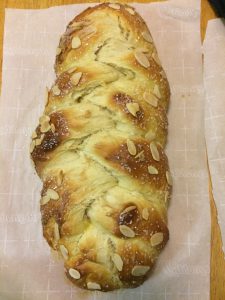
“How is your celebration of the holiday influenced by previous generations?” asked a recent survey in The Weekly Genealogist. The first item in the list of answer choices was “I serve food or drinks that are traditional in my family.“ I quickly checked it off, as I was in the midst of baking, making sure that my kids would come home to the seasonal treats they – and now their spouses – expect.
One thing I have baked at Christmas in recent years is nisu, a sweet Finnish bread I remember eating at the home of my Finnish-born grandmother, known to all her grandkids as Mumma. When I visited Finland in 2012, a second cousin (granddaughter of Mumma’s sister) served it to me, and the scent of the cardamom took me back to my childhood. It is this cousin’s recipe that I now use, and I like to think that it’s the same as Mumma’s. Nisu requires a large bowl. As usual, I got out the big old pottery bowl that belonged to my husband’s German-born grandmother, known to her grandchildren as Granny.
“Mumma, meet Granny,” I thought, as I poured flour into the big bowl. “Granny, meet Mumma.”
It struck me that I was experiencing the melting pot of America in a hands-on kind of a way. “Mumma, meet Granny,” I thought, as I poured flour into the big bowl. “Granny, meet Mumma.” That evening, my daughter and English-born son-in-law came into the kitchen and, exclaiming “Nisu!” began pulling pieces off the warm loaves. The next day my son and his new wife, a daughter of Iranian immigrants, also eagerly dove into the loaves.
Sugar cookies, Linzer tarts, spice drops, and snickerdoodles: all are essential at the holidays at our house, and all are baked using the recipes on my mother-in-law’s well-worn recipe cards. Were some of those recipes Granny Stratton’s German recipes, or did they come from my mother-in-law’s New England family? I don’t know, but they – as well as peanut butter–filled “buckeyes,” made to remind us all of my Ohio roots – are this family’s favorites. It makes me happy that they are enjoyed now by an English son-in-law and Persian daughter-in-law – and that they are sometimes created in my kids’ kitchens, too.
“Where there is a family tradition, there is often food!” read a recent tweet from FamilySearch. “Food brings people together, creating experiences to add to your personal and family history.” To that I say, Amen. And now I will return to reading the Persian cookbook I received for Christmas. Did you know the Persians also use a lot of cardamom?
As I began reading your column by looking at the picture I thought, “Challah!” I expected to read about mixing the Christian and Jewish winter traditions. Well done. Happy New Year!
In fact, this year we put up a menorah as well as an Advent wreath–but so far no challah is in the baking repertoire. Happy new year to you also!
I have Finnish and Swedish roots. Our family makes Swedish braid (bread) that looks very much like your nisu. Are you willing to share your family recipe for nisu? Thank you.
Hi, Wanda–I’d love to learn more about your Finnish roots. This online recipe is very close to what I use, and has all the measurements converted from metrics: http://allrecipes.com/recipe/18123/finnish-nissua/
I spent several months in Stockholm visiting a Swedish sorority sister. Kerstin’s mom was a great baker, and I have fond memories of cardamon and saffron sweetbreads. No Swedish bakeries here so I live on the memories. Thanks for this piece.
Thanks for your comment, Carol!
We also made nisu or nissua as we call it, from my husband’s ancestry; his 4 grandparents emigrated as young people and married here. We also make an oven pancake we call kropsu or kropsua, a name none of my husband’s contemporary Finnish relatives recognized. (They call it pannukakku. Boring!) I’ve wondered about the names and especially the “-a” ending that his family used–from a particular region? Just old-fashioned?